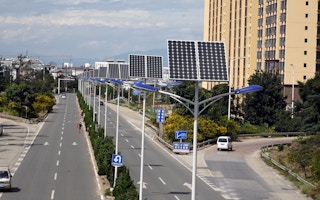Monday Wisdom needs regular power for his metal workshop in Sokoto city, north-west Nigeria. But, unable to rely on the public grid, he depends on a diesel generator, at significant personal expense, pollution and noise.
“I spend no less than 4,000 naira (about US$5) to purchase diesel on a daily basis,” he says. “What’s more, I still have to pay the power distributor’s bill for what I didn’t consume at the end of month.”
Regular power failures in the state mean that many of his colleagues in the welding profession have resorted to taking up less-skilled jobs like bricklaying for survival, he said.
Most Nigerians living in cities experience frequent power cuts, while three-quarters of rural Nigerians remain without access to electricity at all.
One solution to this issue is off-grid solar systems such as rooftop panels and rechargeable solar-powered batteries. Chinese firms have been increasingly active in meeting Nigeria’s growing demand for these.
Grid instability
The condition of the national grid has been steadily deteriorating. In 2011, there were 13 complete grid collapses and six partial outages. By 2022, this had risen to 22 collapses and 20 partial outages. In March of that year, the grid collapsed twice within 48 hours, plunging millions into darkness.
“
Solar power is what matters to all Nigerians now, irrespective of their economic status.
Nuhu Isaac, sales representative, Beebeejump Technology
Just over 55 per cent of Nigeria’s population had access to electricity in 2020, according to data from the World Bank. That’s far lower than the global proportion of 90 per cent, though higher than the 48 per cent for all of sub-Saharan Africa. The regular grid failures mean generated electricity frequently goes to waste.
The government launched a plan last year to cut the country’s greenhouse gas emissions to net zero by 2060, and ensure all Nigerians are provided with electricity by 2030, in line with UN Sustainable Development Goal 7.
The plan aims to phase out diesel and petrol generators, which are widely used across Nigeria, and expand capacity of both gas-fired and renewable electricity generation. It specifies that renewables will be an important part of “electrification … in sectors such as buildings, industry and transport.”
Renewable energy renews hopes
The Nigerian solar off-grid market has grown at an average annual rate of 22 per cent over the past five years, among the fastest in Africa, notes Nikki Adams, team lead at Prime Renewable Energy Solution, a company based in the capital, Lagos. He says this is partly due to the strong need for alternatives to the faulty power grids, as well as recent government policies favouring solar installations.
In 2021, Nigeria and China signed an agreement to boost renewable electricity in the West African country. The idea was to build and upgrade renewable energy facilities nationwide, and increase electricity supply in rural areas.
As a result of the pact, 200 sets of off-grid photovoltaic (solar) equipment were donated to Nigeria’s rural communities by PowerChina-Kunming Engineering Corporation and Yunnan province’s Department of Commerce. The donation was made under a scheme called “Green Energy Africa, One Belt, One Road Lightening Up of Thousands of Households”.
China Dialogue spoke to a recipient of the equipment, Magaji Shehu, 83-year-old head of the Gidan Yunfa community in Sokoto. He described it as a “dream” to most community members, who had lost hope of living in an electrified environment.
Prior to having the solar energy supply, villagers used to go to bed early, he said. But now, children play around the streetlights. “We are very happy to have this electricity project in our domain.”
Garba Ali, a 34-year-old farmer, said the community is happier with off-grid solar than a connection to the national grid, given the latter’s unreliability.
Meeting demand
It is not only overseas donations that have found a place in Nigeria’s solar-powered system. Chinese firms are “providing Nigerians with affordable solar panels, solar street lights, energy-saving bulbs, rechargeable lamps and fans, among other clean-energy products,” says Amadi Joshua, an electrical engineer with AY Global Energy, an Abuja-based solar power company.
Nuhu Isaac, a sales representative with Beebeejump Technology, a company based in Shenzhen with multiple offices in Nigeria, said: “Solar power is what matters to all Nigerians now, irrespective of their economic status.” The company says it sells off-grid solar products across all of Nigeria’s 36 states, using flexible billing and payment solutions to reach more customers.
Nnaji Collins, Nigeria customer service manager for Kang Ming Sheng Technology, another Shenzhen-based company, says they have helped in providing alternative power sources to millions of Nigerians, especially in remote areas. “Our rechargeable bulbs and solar bulbs serve millions of poultry farmers as well as shop owners,” he tells China Dialogue.
Solar future
Babatunde Fashola, former minister of works, power and housing, is optimistic about solar power development in Nigeria.
“The prospects of clean energy leapfrogging conventional sources are certainly within reach for Nigeria,” Fashola said. He added that this is particularly in light of rising diesel costs, “and partly due to the increased market penetration of renewable energy solutions.”
Chinese companies are likely to continue playing a role. At the 3rd Belt and Road Forum, held in Beijing in October, the Nigeria government received US$4 billion worth of “letters of intent” for investments and new projects in solar, clean energy and smart grid initiatives.
But with grid collapses and blackouts still a common reality, off-grid solar will have to develop quickly in order to provide better and cleaner power connectivity for Nigerians by 2030 – the government’s target year for universal energy access.
This article was produced as a result of a grant provided by the Africa-China Reporting Project at the Wits Centre for Journalism at the University of the Witwatersrand, Johannesburg. The views expressed are the author’s.
This article was originally published on China Dialogue under a Creative Commons licence.










